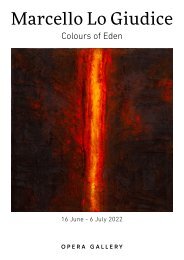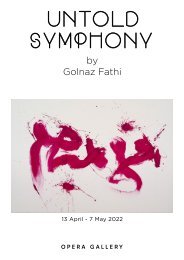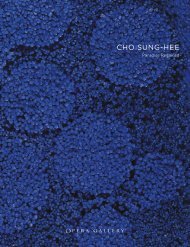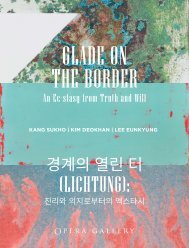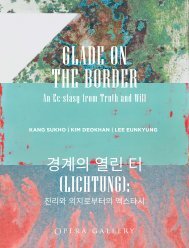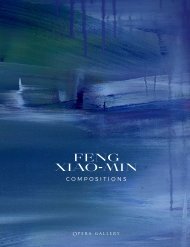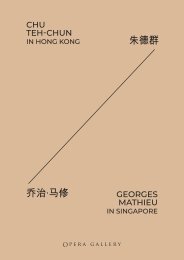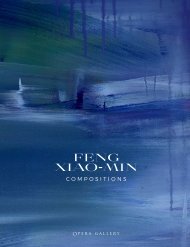Salon Art + Design NYC 2020
Salon Art + Design NYC 2020 November 2020 Opera Gallery New York
Salon Art + Design NYC 2020
November 2020
Opera Gallery New York
Create successful ePaper yourself
Turn your PDF publications into a flip-book with our unique Google optimized e-Paper software.
Preface<br />
In a world slowed down by unprecedented events, the worlds of <strong>Art</strong> and <strong>Design</strong> have<br />
continued to thrive. This November, the ninth edition of <strong>Salon</strong> <strong>Art</strong> + <strong>Design</strong> opens<br />
online, and Opera Gallery is delighted to be part of this fair, which seizes opportunity<br />
from the limitations of the current global paradigm, turning restrictive conditions on<br />
their head, in a digital and interactive magazine format. <strong>Salon</strong> <strong>Art</strong> + <strong>Design</strong> features<br />
over sixty international galleries, exhibiting artists from all around the world.<br />
Each year, Opera Gallery strives to exhibit the very best of the contemporary art world,<br />
elevating the artists who will become the designers of our generation. This year’s<br />
edition is all the more important for proving that, no matter the challenges, innovation<br />
and creativity always find a way to show us the best of human creation.<br />
For the <strong>2020</strong> online edition, Opera Gallery has chosen to present artists from all genres<br />
and backgrounds, from the renowned modern painter and sculptor Fernando Botero<br />
to contemporary master of geometrical shapes Anthony James.<br />
This exhibition presents an exceptional selection of works on canvas and paper,<br />
sculptures, and other media from such timeless artists as Ai Weiwei, Ron Arad, Pablo<br />
Atchugarry, Fernando Botero, Alexander Calder, George Condo, Jean Dubuffet,<br />
Anthony James, Alex Katz, Yves Klein, Yayoi Kusama, Julian Opie, Niki de Saint Phalle<br />
and Manolo Valdés.<br />
Gilles Dyan<br />
Founder and Chairman<br />
Opera Gallery Group<br />
Laura Adams<br />
Director<br />
Opera Gallery New York<br />
5<br />
4
Alexander CALDER<br />
(1898-1976)<br />
Alexander Calder was born in Philadelphia, Pennsylvania, USA in 1898. He was the son<br />
of Alexander Stirling Calder and grandson of Alexander Milne Calder, both well-known<br />
sculptors. After obtaining his mechanical engineering degree from the Stevens Institute<br />
of Technology, Calder worked various jobs before enrolling at the <strong>Art</strong> Students League in<br />
New York City in 1923. It was here that he finished his first miniature travelling circus and<br />
began making a name for himself as an innovative Abstract sculptor. Calder is known<br />
as the originator of the suspended or standing kinetic sculpture made from delicately<br />
balanced shapes and set in motion by air currents; a device Marcel Duchamp named<br />
‘mobiles’. He was awarded the main prize for sculpture at the Venice Biennial in 1952 and<br />
first prize for sculpture in the 1954 Pittsburgh International. Calder created a series of<br />
paintings in gouache during a yearlong stay in Aix-en-Provence, France in 1953 in parallel<br />
to his sculptural practice. The gouache allowed Calder to quickly translate the vocabulary<br />
of his sculpture into something more immediate, using an Angular Figuratism, which<br />
often served as inspiration for later sculpted works. Presenting a synthesis of geometric<br />
forms, Calder’s lines convey, with considered simplicity, the abundance and diversity of<br />
nature and the spontaneous impressions it evokes.<br />
His works are held in almost every major museum collection worldwide including the<br />
Centre Georges Pompidou in Paris, the Museum of Modern <strong>Art</strong> in New York, the Neue<br />
Nationalgalerie in Berlin or the Fondation Beyeler in Basel.<br />
7<br />
6
Rocher au cœur rouge<br />
1974<br />
Dated and incised with the artist monogram on the base<br />
Painted Metal and wire<br />
Unique piece<br />
42.5 x 43.7 x 27 in<br />
108 x 111 x 68.5 cm<br />
Provenance<br />
Perls Galleries, New York<br />
Mr. and Mrs. James W. Alsdorf, Chicago, 1974<br />
Private collection, Paris<br />
Christie’s, London, 30 June 1994, lot 45<br />
Michael Haas, Berlin<br />
Sotheby’s, London, 24 October 1996, lot 47<br />
Private collection<br />
Exhibited<br />
New York, Perls Galleries, Alexander CALDER: Crags and Critters of 1974, October - November 1974<br />
Basel, Galerie Beyeler, Wer Hat Angst Rot, June - September 1995<br />
London, Hellly Nahmad Gallery, Love, March - May 2000<br />
Beverly Hills, Gagosian Gallery, Alexander Calder, May - June 2003<br />
New-York, Hammer Galleries, Object in Space: Léger, Miró, Calder, November 2012 - January 2013<br />
Literature<br />
New York, Hammer Galleries, Objects in space: Léger, Miro, Calder, November 2012-January 2013, pp. 70-71, 86 ill.<br />
New York, Perls Galleries, Alexander Calder: Crags and Critters of 1974, October - November 1974, no. 7<br />
London, Helly Nahmad Gallery, Love, March-May 2000, no. 29<br />
Certificate<br />
The work is registered in the archives of the Calder Foundation, New York<br />
8
Red Octopus<br />
1971<br />
Signed and dated on the lower right<br />
Gouache on paper<br />
29.5 x 42.9 in<br />
75 x 109 cm<br />
Provenance<br />
Pearls Gallery, New York<br />
Private collection, Spain<br />
<strong>Art</strong> Trade, Spain<br />
Certificate<br />
This work is registered in the archives of the Calder Foundation, New York<br />
10
Osaka<br />
1970<br />
Signed and dated on the lower right, titled and numbered on the reverse<br />
Gouache on paper<br />
29.3 x 42.3 in<br />
74.5 x 107.5 cm<br />
Provenance<br />
Galerie Maeght, Paris<br />
Galleria Angolare, Milan, 1974<br />
Private collection, Massachusetts<br />
Certificate<br />
This work is registered in the archives of the Calder Foundation, New York<br />
12
Pablo ATCHUGARRY<br />
(b. 1954)<br />
Pablo Atchugarry was born in 1954 in Montevideo, Uruguay. Working at first with cement<br />
and iron in the 1970s, he rose to prominence for his works in marble in the 1980s. He was<br />
awarded the Michelangelo Award from the city of Carrara, Italy, in 1999 for his artistic<br />
achievements in working with Carrara marble. The following year, he represented Uruguay<br />
at the 50 th Venice Biennale with the sculpture Soñando la Paz, an eight-piece-work<br />
work in Carrara and Bardiglio della Garfagnana marble. In 2007, the artist established<br />
the nonprofit institution Fundación Pablo Atchugarry in Manantiales, Uruguay, which<br />
promotes visual arts, music, and literature in the community.<br />
His work is exhibited in numerous museums and public institutions worldwide, including<br />
the National Museum of Visual <strong>Art</strong>s of Montevideo, Uruguay; the Parco Museum of<br />
Parco de Portofino, the Lercaro Museum of Bologna, the Collection of the Province of<br />
Milan, Italy; the Franc Daurel Foundation in Barcelona, Spain ; the Groeningemuseum<br />
in Bruges, Belgium; the Berardo Collection in Portugal; the Perez <strong>Art</strong> Museum in Miami,<br />
USA and the Chrysler Museum of <strong>Art</strong> in Norfolk, UK. Atchugarry’s works can be found<br />
in public and private collections internationally. He currently lives and works between<br />
Lecco, Italy, and Manantiales, Uruguay.<br />
15<br />
14
Untitled<br />
2019<br />
Carrara Marble<br />
Unique piece<br />
39.8 x 16.9 x 16.9 in<br />
101 x 43 x 43 cm<br />
Provenance<br />
<strong>Art</strong>ist’s studio<br />
16
Manolo VALDÉS<br />
(b. 1942)<br />
Born in Valencia, Spain, in 1942, Manolo Valdés is one of the few artists who have mastered<br />
multiple mediums including drawing, painting, sculpture and printmaking. In each form<br />
he is considered highly original, technically sound and constantly provocative.<br />
Manolo Valdés began training as a painter in 1957 at the Real Academia de Bellas <strong>Art</strong>es<br />
de San Carlos de Valencia, Spain. In 1964, Valdés formed the group Equipo Crónica,<br />
with Joan A. Toledo and Rafael Solbes; Toledo left the group after a year but Valdés<br />
and Solbes continued their association with Equipo Crónica until the death of Solbes in<br />
1981. Thanks to this group, Manolo Valdés participated in over sixty solo exhibitions and<br />
numerous group exhibitions until 1981.<br />
After 1981, Valdés embarked on a solo career focusing on <strong>Art</strong> History motifs: his work<br />
often quotes figures from well-known pieces of art, revitalizing its image through a<br />
change of context. Manolo Valdés moved away from linear irony to interpret the image<br />
as a symbol and a vehicle for contact between the work of <strong>Art</strong> and the spectator. He has<br />
continued to seek inspiration in the creations of the grand masters of the History of <strong>Art</strong><br />
such as Velázquez, Rembrandt or Goya.<br />
Influenced by historical masterpieces, Valdés creates large works in which the lighting<br />
and colors express a sensation of tactility. His work is forceful and decorated with<br />
historical art symbols. The timelessness of the image as the axis of the visual experience<br />
is the determining factor in his creations. In his works, image and matter are fused in<br />
a body of work that wanders between Pop <strong>Art</strong> and material art, between social and<br />
political commitment and a continuous search for reinvention.<br />
Throughout his long career, Valdés has never stopped investigating and reinventing<br />
<strong>Art</strong>, with an insatiable appetite for conceptual and plastic experimentation. The result<br />
is unanimous critical acclaim and recognition from a growing public for his works that<br />
can be found in the great museums of the world. Manolo Valdés’ works are included<br />
in several private and public collections around the world, including but not limited<br />
to Peggy Guggenheim collection in Venice, Metropolitan Museum of <strong>Art</strong> in New York,<br />
Centre Georges Pompidou in Paris, Guggenheim Bilbao in Spain, and the de Young<br />
Museum in San Francisco.<br />
19<br />
18
Matisse como Pretexto con Azul y Rojo<br />
<strong>2020</strong><br />
Mixed media<br />
51.2 x 39.4 in<br />
130 x 100 cm<br />
Provenance<br />
<strong>Art</strong>ist’s studio<br />
20
Clio Dorada<br />
2018<br />
Bronze with Gold Patina and Steel<br />
Edition of 9<br />
45.7 x 36.4 in<br />
116 x 92.5 cm<br />
Provenance<br />
<strong>Art</strong>ist’s studio<br />
22
Portrait I<br />
2018<br />
Mixed media on burlap<br />
65 x 55.1 in<br />
165 x 140 cm<br />
Provenance<br />
<strong>Art</strong>ist’s studio<br />
24
Jean DUBUFFET<br />
(1901 - 1985)<br />
Born in Le Havre, France, Jean Dubuffet is considered the founding father of <strong>Art</strong> Brut.<br />
Rejecting traditional fundamentals of art and institutionalized culture, Dubuffet twice<br />
declared to leave the world of art before devoting himself full time in 1942. His interest in<br />
works of art produced by people working outside of aesthetic norms, such as children,<br />
prisoners and psychiatric patients, became the core of his artistic philosophy, and he<br />
remains one of the most controversial Post-War French artists in history. Dubuffet’s<br />
œuvre includes paintings, collages, sculptures and monuments.<br />
1974 marked the end of Dubuffet’s highly esteemed ‘Hourloupe’ cycle, a twelve-year<br />
project that became the artist’s most formative series. During the last ten years of his<br />
life, Dubuffet made a series of works with colored pencil and felt tip pen on paper. In<br />
the artist’s own words, these works were ‘excursions of the mind into no man’s land.’<br />
Expanding his color palette and revisiting collage techniques from earlier periods in his<br />
career, these more intimate drawings embody the artist’s signature structural approaches<br />
to color and form.<br />
Retrospectives of his works have been held in famous international museums such as<br />
the Palazzo Grassi in Venice, the Tate Gallery in London, the Centre Georges Pompidou<br />
in Paris and the Solomon R. Guggenheim Museum in New York.<br />
27<br />
26
Personnage (P374)<br />
1972<br />
Monogrammed and dated on the lower right<br />
Marker and collage on paper<br />
19.8 x 11.5 in<br />
50.2 x 29.2 cm<br />
Provenance<br />
Pace Gallery, New York<br />
Private collection, New York<br />
Sotheby’s, New York, 18 November 1999, lot 361<br />
Private collection<br />
Exhibited<br />
Wilmington, Delaware <strong>Art</strong> Museum, Dubuffet, 14 - 28 March 1974<br />
New York, The Pace Gallery, Dubuffet: Studies for a Spectacle, 5 May - 27 June 1973, catalogue no. 10<br />
Literature<br />
Max Loreau, Catalogue des travaux de Jean Dubuffet, Fascicule XXVII : Coucou Bazar, Weber editions, Lausanne, 1976,<br />
p. 84, no. 151, ill.<br />
28
Élément bleu XII<br />
1967<br />
Signed JD and dated on the lower right side<br />
Transfer on polyester resin<br />
78.7 x 37.8 x 3.9 in<br />
200 x 96 x 10 cm<br />
Provenance<br />
<strong>Art</strong>ist’s studio<br />
Galerie Jeanne Bucher, Geneva, 1967<br />
Collection Georges Braunschweig, La Chaux-de-Fonds, 1968<br />
Elvire and Philippe Braunschweig collection, Villa Turque, La Chaux-de-Fonds, 1975<br />
Valerie Braunschweig collection, New York, 1992<br />
Literature<br />
Max Loreau, Catalogue des travaux de Jean Dubuffet, sculptures peintes, fascicule XXIII, Lausanne 1972, p. 81, no.61, ill..<br />
30
Niki de SAINT PHALLE<br />
(1930-2002)<br />
Niki de Saint Phalle is a French-American artist who was born in Neuilly-sur-Seine,<br />
France, and grew up in New York. A self-taught artist, she lived and worked between<br />
France, Switzerland and the United States.<br />
Niki de Saint Phalle was part of the Nouveaux Réalistes group, which she joined in<br />
1964 through her husband, artist Jean Tinguely. She first received worldwide attention<br />
for angry, violent assemblages which she had shot using firearms. These evolved into<br />
Nanas, light-hearted, whimsical, colorful, large-scale sculptures of animals, monsters,<br />
and female figures, first made of wool, yarn, paper-maché and wire scaffoldings and<br />
later made of polyester. These voluptuous female figures served to represent the ideal<br />
archetype for women in modern society, and can be seen in cities and museums all over<br />
the world.<br />
Saint Phalle’s monumental works are exhibited at the Stravinsky Fountain, next to the<br />
Pompidou in Paris (1983), the Tarot Garden in Garavicchio, South of Tuscany (1998), the<br />
Grotto in the Royal Garden Herrenhausen of Hannover (2003), and Queen Califia’s Magic<br />
Circle in California (2003). Her works are also held in the collections of the Courtauld<br />
Institute of <strong>Art</strong> in London, the Museum of Modern <strong>Art</strong> in New York, the Walker <strong>Art</strong> Center<br />
in Minneapolis, and the Musée d’<strong>Art</strong> Moderne d’<strong>Art</strong> Contemporain in Nice, among others.<br />
33<br />
32
Je suis à l’envers<br />
1998<br />
Acrylic on polyester resin<br />
Edition of 5<br />
46.1 x 31.5 x 5.5 in<br />
117 x 80 x 14 cm<br />
Provenance<br />
Tasende Gallery, La Jolla<br />
Private collection<br />
Literature<br />
Mingei International Museum of San Diego, Niki de Saint Phalle - insider / outsider - world inspired art, La Jolla, Mingei<br />
International Museum, 1998, p. 117, ill.<br />
Michel de Grèce, Niki de Saint-Phalle Catalogue Raisonné 1949 - 2000, Vol. I, Lausanne, Acatos, 2001, p. 294, no. 645, ill.<br />
34
Oiseau<br />
1968<br />
Painted fiberglass<br />
Unique piece<br />
32.9 x 54.7 x 9.1 in<br />
83.5 x 139 x 23 cm<br />
Provenance<br />
Schuler Auktionen, 19 March 2010, lot 4081<br />
Private collection, Europe<br />
Certificate<br />
The work is registered with the Archives Niki Charitable <strong>Art</strong> Foundation, Santee<br />
36
AI Weiwei<br />
(b.1957)<br />
Ai Weiwei was born in 1957 in Beijing, China. He is one of the most influential artists<br />
of our time and is known worldwide for his art and activism, ranging from sculptural<br />
installations, architectural projects to photographs or videos.<br />
During his childhood his father, the poet Ai Ging, was sent to a labor camp as an enemy<br />
of the revolution; Ai Weiwei then grew up in exile in a remote Chinese county until 1976.<br />
After attending the Beijing Film Academy from 1978 to 1981, Ai moved to New York and<br />
briefly attended Parsons School of <strong>Design</strong>. He returned to China in 1993 and participated<br />
in establishing the community of experimental artists Beijing East Village.<br />
Ai’s art is driven by social activism, often criticizing the sociopolitical system in China.<br />
His provocative and subversive art testify his political beliefs and triggered several forms<br />
of repression from Chinese authorities. He was incarcerated for months in 2011, then<br />
released to house arrest. Despite being forbidden to travel outside of China or engaging<br />
public speeches, the artists keeps creating pieces of art that openly confront Chinese<br />
Communist leadership and promoting freedom of expression.<br />
Ai was awarded numerous prizes and recognitions such as the Chinese Contemporary<br />
<strong>Art</strong> Award in 2008, the Skowhegan Medal in 2011 or the Honorary Academician at the<br />
Royal Academy of <strong>Art</strong>s, London in 2011. His work can be found in the greatest museums<br />
worldwide and has been the subject of numerous solo shows in institutions such as<br />
the Tate Modern, London, Taipei Fine <strong>Art</strong> Museum, Hirshhorn museum and Sculpture<br />
Garden, Washington DC or Indianapolis Museum of <strong>Art</strong>, among others.<br />
39<br />
38
Marble Chair<br />
2008<br />
Marble<br />
46.5 x 22 x 17.1 in<br />
118.1 x 55.9 x 43.5 cm<br />
Provenance<br />
Lisson Gallery, New York<br />
Private collection<br />
Certificate<br />
The artist confirmed the authenticity of the artwork<br />
Exhibited<br />
Madrid, Ivorypress, AI Weiwei. Ways beyond art, 2009<br />
Literature<br />
Elena Ochoa Foster and Hans Ulrich Obrist, AI Weiwei. Ways beyond art, vorypress Ed., Spain, 2009, pp. 50-51<br />
40
Yayoi KUSAMA<br />
(b. 1929)<br />
Yayoi Kusama is born in Matsumoto, Japan in 1929. She came to prominence as a<br />
leading figure in the Post-War Avant-Garde in the United States, where she developed a<br />
multi-faceted, conceptually-based practice that incorporates installation, performance,<br />
painting and collage. While hugely influential upon an emerging generation of artists,<br />
commercial success escaped her and she returned to Japan in the 1970s, where she<br />
voluntarily checked herself into a psychiatric institution from which she has worked ever<br />
since. She is now widely recognized among the most important living Japanese artists.<br />
Yayoi Kusama is a protean artist who participated to the Pop <strong>Art</strong> movement in the<br />
United States, but she doesn’t really belong strictly to a single <strong>Art</strong> movement. Her work<br />
has also a strong psychedelic characteristic as she is influenced by an hallucinatory<br />
episod she encountered when she was younger. The polka dot is her trademark and it is<br />
very represented in her work.Kusama was also a major figure in the performance field in<br />
the US, she started her first happenings in the late 1950s. Her happenings often included<br />
nudity and highlight political questions, which make her a pioneer in this category.<br />
43<br />
42
Infinity-Nets (KSUZL)<br />
2017<br />
Signed, titled and dated<br />
Acrylic on canvas<br />
63.7 x 51.4 in<br />
161.9 x 130.5 cm<br />
Provenance<br />
OTA Fine <strong>Art</strong>s, Singapore<br />
David Zwirner, New York<br />
Private collection<br />
Certificate<br />
Yayoi Kusama, Inc. has confirmed the authenticity of this work<br />
44
Alex KATZ<br />
(b. 1927)<br />
Alex Katz was born in 1927 in Brooklyn, New York, USA, to a Russian family. A true child<br />
of the Five Boroughs, Katz grew up in the St. Albans suburbs in Queens and graduated<br />
from Manhattan’s Copper Union in 1949 where he studied Modern <strong>Art</strong> theories and<br />
techniques under Morris Kantor. Katz’s experience of plein air painting at the Skowhegan<br />
School in Maine was pivotal in his development as a painter. The artist experiments<br />
with color – using monochrome backgrounds in his artworks early on, dimensions, scale<br />
and materials. From the 1950s and on, Katz worked on a range of subjects and genres<br />
such as portraits, landscapes and still life such as flowers. His wife and muse, Ada, is<br />
often represented in his paintings. The painter reduces scenes or movement unto a flat<br />
surface with clean-cut contours. Katz also experimented with designing theatre sets and<br />
costumes. Considering himself a Post-Abstract painter, Katz is interested in exploring<br />
how “realism” can be redefined.<br />
His work has been exhibited extensively since the 1950s. The painter’s work from different<br />
decades of his career and on various medium were subject of museum exhibitions<br />
at renowned institutions such as the Tate Gallery and the National Portrait Gallery in<br />
London; the Guggenheim Museum in Bilbao, Spain ; the Albertina Museum in Vienna and<br />
the Metropolitan Museum of <strong>Art</strong>, New York. He has received many awards throughout<br />
his lauded career and his work is featured in more than 100 public collections worldwide.<br />
47
Roses on Blue<br />
2002<br />
Signed and dated on the overlap<br />
Oil on canvas<br />
48 x 150 in<br />
122 x 381 cm<br />
Provenance<br />
Pace Gallery, New York<br />
Private collection<br />
Literature<br />
New York, Pace Gallery, Alex Katz, Flowers and Landscapes, October - November 2003, pp. 40, 47, ill.<br />
49
George CONDO<br />
(b. 1957)<br />
George Condo was born in Concord, New Hampshire, USA, in 1957. He lives and works in<br />
New York. Condo is recognized as being one of America’s most influential living artists. In<br />
a career spanning more than three decades, Condo’s highly original and distinctive body<br />
of work has consistently drawn upon art historical traditions and genres, the portrait<br />
particularly, in order to hold a mirror up to contemporary social mores. Condo first started<br />
exhibiting his hybrid style paintings in the 1980s. His work daringly fused the sensibilities<br />
of European Old Master painting with references to popular American culture, including<br />
Playboy magazine, comics and cartoons. Condo coined the term “<strong>Art</strong>ificial Realism”, to<br />
describe his approach or, in other words, “the realistic representation of that which is<br />
artificial”. Between 1985 and 1995, Condo worked in both Paris and New York, and spent<br />
a considerable amount of time in the French capital where he met writer William S.<br />
Burroughs (with whom he has collaborated) and the philosopher Félix Guattari, who<br />
has written extensively on his work. Throughout his career, Condo has never deviated<br />
from his personal vision. His unique pictorial inventions, “imaginary portraits” and often<br />
grotesque but classically executed paintings continue to surprise and, at times, horrify.<br />
His works feature in important public and private collections, including the Museum of<br />
Modern <strong>Art</strong>, the Metropolitan Museum of <strong>Art</strong>, and the Whitney Museum of American <strong>Art</strong>,<br />
New York; the Museu d’<strong>Art</strong> Contemporani de Barcelona; the Astrup Fearnley Museet,<br />
Oslo and the Fonds National d’<strong>Art</strong> Contemporain, Paris.<br />
51<br />
50
Whistler’s Father<br />
2019<br />
Signed and dated on the upper left<br />
Acrylic and oil stick on canvas<br />
76 x 74 in<br />
193 x 188 cm<br />
Provenance<br />
Skarstedt Gallery, New York<br />
Private collection<br />
52
Untitled<br />
2015<br />
Signed and dated on the upper left<br />
Graphite on paper<br />
30.2 x 44 in<br />
76.8 x 111.8 cm<br />
Provenance<br />
Skarstedt Gallery, New York<br />
Private collection, 2015<br />
54
Anthony JAMES<br />
(b. 1974)<br />
Anthony James is a British-American artist based in Los Angeles, known for his<br />
monumental installations and sculptures. He was born in England in 1974 and studied in<br />
London at Central Saint Martins College of <strong>Art</strong> and <strong>Design</strong> from 1994 to 1998. His work<br />
gestures towards minimalism, materiality, process, alchemy, language, mechanisation<br />
and experimentation with light and space.<br />
James’ objects show a formal certainty and perspicuity (exact symmetry, white light,<br />
accurate shape) that registers purity, autonomy and wholeness. His works illustrate<br />
ideals, but they themselves are very contingent and actual: they are for today.<br />
The sculptures operate between the iconic and the arbitrary, the concrete and the<br />
alchemic, the mythical and the experiential. James describes his work as, “evoking pictorial<br />
depictions of the cosmos, alluding to notions of mysticism, ethereality, spirituality and<br />
science, all the while anchored through the use of weighty, industrial materials”.<br />
His globes of multiple geometrical facets come from a mathematical experiment in<br />
unity used by Plato to demonstrate an ideal compositional system of perfect symmetry<br />
in three dimensions. In a twenty-first century gallery space, the glass, steel, and LED<br />
structures bring a rigid and gleaming tangibility to the abstraction of the numerical<br />
calculation of flawless coherence. James’ artworks are compelling approximations,<br />
facsimiles of understanding and belief thousands of years old that come down to us on<br />
our own terms of modern metals and technological light.<br />
Anthony James has exhibited in several international Museums. His first monograph,<br />
‘Morphic fields’, was published by Hatje Cantz in 2014. His work has recently been<br />
exhibited at Crystal Bridges Museum, ‘Crystals in <strong>Art</strong>, ancient and today’, Bentoville, USA<br />
(October 2019 - January <strong>2020</strong>), curated by Joachim Pissarro and Lauren Hayes.<br />
57<br />
56
60” Triacontahedron (Solar Black)<br />
<strong>2020</strong><br />
Stainless steel, glass, LED, Solar Black finish<br />
Edition of 6<br />
60 x 60 in<br />
152.4 x 152.4 cm<br />
Provenance<br />
<strong>Art</strong>ist’s studio<br />
58
60” Great Rhombicosidodecahedron (Solar black)<br />
<strong>2020</strong><br />
Stainless steel, glass, LED, Solar Black finish<br />
Edition of 6<br />
60 x 60 x 60 in<br />
152.4 x 152.4 x 152.4 cm<br />
Provenance<br />
<strong>Art</strong>ist’s studio<br />
60
Julian OPIE<br />
(b. 1958)<br />
Julian Opie is a Contemporary artist from London, England. He graduated from<br />
Goldsmiths College of <strong>Art</strong> in 1982 where he trained under Michael Craig-Martin. His<br />
instantly recognizable figurative artworks are a synthesis of the traditions of Minimalism<br />
with Pop <strong>Art</strong> and Contemporary digital processes. One of Opie’s most notable<br />
commissions was the design of an album cover for British Pop band Blur in 2000, for<br />
which he received a Music Week CADS award. In 2006, he created an LED projection for<br />
U2’s Vertigo world tour, and in 2008 Opie created a set design for Wayne McGregor’s<br />
ballet INFRA for The Royal Opera House in London.<br />
Opie has presented many public projects in cities around the world, notably in the<br />
Dentsu Building in Tokyo, City Hall Park in New York, Mori Building, Omotesando Hill in<br />
Tokyo, River Vltava in Prague, Phoenix <strong>Art</strong> Museum USA, Dublin City Gallery in Ireland,<br />
Seoul Square in South Korea, Regent’s Place in London, Calgary, Canada, The Lindo<br />
Wing, St Mary’s Hospital, London and more recently permanent installations at SMETS<br />
in Belgium, PKZ in Zurich and Carnaby Street, London, UK.<br />
His works are held in many major museum collections including the <strong>Art</strong>s Council of<br />
England, the Carnegie Museum in Pittsburgh, The IVAM in Valencia, the MoMA in New<br />
York, the MoMAT in Tokyo, The National Gallery of Victoria in Melbourne, the Stedelijk<br />
Museum in Amsterdam, the British Museum, the National Portrait Gallery, the Tate Gallery<br />
and Victoria and Albert Museum in London.<br />
63<br />
62
Mini skirt girl. 1.<br />
2014<br />
Vinyl on wooden stretcher<br />
78.7 x 39.4 in<br />
200 x 100 cm<br />
Provenance<br />
<strong>Art</strong>ist’s studio<br />
Private collection<br />
64
Ron ARAD<br />
(b. 1951)<br />
Ron Arad is an Israeli designer born in Tel Aviv in 1951. He studied at the Jerusalem<br />
<strong>Art</strong> Academy and at the Architectural Association in London. After graduating, in 1981<br />
he established his own design and production company “One-off” where he created<br />
unique works by fusing together partially ready and ready-made pieces. A few years<br />
later his company became Ron Associates Architecture and <strong>Design</strong>, and that is when<br />
his carreer took a turn and he focused his time on developping new ides with welding,<br />
beating steel, forging materials to form rigid and rough shapes, thus, the Big Easy chair<br />
was created.<br />
His objects are the result of a constant experimentation of raw materials such as steel,<br />
aluminum or polyamide which he distorts into sinusoidal, elliptical and oval forms.<br />
Alongside his studio work, Arad designs for many leading international companies<br />
including Kartell, Vitra, Moroso, Fiam, Driade, Alessi, Cappellini, Cassina, WMF and Magis<br />
amongst many others. He was also a Professor of <strong>Design</strong> Product at the Royal College<br />
of <strong>Art</strong> in London from 1997 until 2009.<br />
He was awarded the 2011 London <strong>Design</strong> Week Medal for design excellence and became<br />
an Academician of the Royal Academy of <strong>Art</strong>s in 2013. Ron Arad has designed a number<br />
of public art pieces such as the Vortex in Seoul, and the Kesher Sculpture at the Tel Aviv<br />
University.<br />
67<br />
66
Big Easy<br />
1988<br />
Signed and numbered on the bottom right<br />
Painted steel with stainless steel<br />
<strong>Art</strong>ist proof, edition of 5<br />
51.2 x 39.4 x 35.4 in<br />
130 x 100 x 90 cm<br />
68
Yves KLEIN<br />
(1928-1962)<br />
Yves Klein was one of the most important artists in Post-War European <strong>Art</strong> and a key<br />
figure in the French artistic movement Nouveau Réalisme, which was founded in 1960<br />
by the art critic Pierre Restany.<br />
He was born in Nice to parents both painters Fred Klein and Marie Raymond. Autodidact,<br />
Klein learned to paint on his living in an artisitc environment following him from Paris to<br />
Nice.<br />
Klein is known above all for his blue monochrome paintings, which were rendered in<br />
International Klein Blue, a bright blue pigment that was to become the artist’s trademark,<br />
under the appellation IKB. Even though he has always worked with blue during his<br />
carreer, it is not until 1958 that he focused everything on it, and that the coulor he<br />
created became an art of his own.<br />
Influenced by Zen and other metaphysical philosophies, Klein believed his blue paintings<br />
opened onto an immaterial and infinite space that was akin to a pure idea. As the<br />
artist once famously said, “Blue has no dimensions, it is beyond dimensions, whereas<br />
the other colors are not”. Klein’s style is also strongly inspired by the four elements of<br />
nature: air, wind, fire, water that he lengthily discussed with his friends Claude Pascal and<br />
Armand Fernandez.<br />
Klein’s works have been exhibited in numerous museums and is part of important private<br />
and public collections across the world.<br />
71<br />
70
Table IKB®<br />
2017<br />
Blue pigment in glass, plexiglass and<br />
chrome-plated metal<br />
15 x 49.2 x 39.4 in<br />
38 x 125 x 100 cm<br />
72
Table Monogold<br />
2017<br />
Gold leaf in glass, plexiglass and<br />
chrome-plated metal<br />
15 x 49.2 x 39.4 in<br />
38 x 125 x 100 cm<br />
74
Table Monopink<br />
2018<br />
Pink pigment in glass, plexiglass and<br />
chrome-plated metal<br />
15 x 49.2 x 39.4 in<br />
38 x 125 x 100 cm<br />
76
Fernando BOTERO<br />
(b.1932)<br />
Fernando Botero is one of the most prominent and celebrated Latin American artists<br />
in the world. He was born in Medellín, Colombia, in 1932 and was only sixteen years old<br />
when his drawings were first published in a popular local newspaper. In 1958, he rose to<br />
national prominence when he won the first prize at the Salón de <strong>Art</strong>istas Colombianos,<br />
and during the subsequent four decades, he achieved international recognition for his<br />
contribution to Latin American art and culture.<br />
His signature ‘Boterismo’ style, depicting figures with exaggerated volume in staged<br />
scenarii, represents an acute social and political critique alongside the more prosaic<br />
aspect of Colombian life. Recurrent themes address family life, religion, bullfight, and<br />
circus culture, all filtered through his unique, darkly humorous lens. His art is included in<br />
important private collections alongside numerous major museums collections. In 2012,<br />
he was awarded the International Sculpture Center’s Lifetime Achievement Award.<br />
81<br />
80
Standing Woman<br />
1995<br />
Signed, numbered and marked with foundry stamp<br />
Bronze<br />
Edition of 6<br />
29.5 x 7.9 x 7.9 in<br />
75 x 20 x 20 cm<br />
Provenance<br />
<strong>Art</strong>ist’s studio<br />
Private collection<br />
Certificate<br />
The artist confirmed the authenticity of this work<br />
Litterature<br />
Fernando Botero: Sculpture, Waddington Custot, London, 2019, no. 8, p46, ill.<br />
82
NEW YORK<br />
791 Madison Avenue<br />
New York, NY 10065<br />
T. + 1 646 707 3299<br />
nyc@operagallery.com<br />
MIAMI<br />
151 NE 41st Street, Suite 131,<br />
Paradise Plaza<br />
Miami <strong>Design</strong> District<br />
Miami, FL 33137<br />
T. + 1 305 868 3337<br />
miami@operagallery.com<br />
BAL HARBOUR<br />
The St. Regis Bal Harbour Resort<br />
9703 Collins Avenue, Lobby Floor<br />
Miami Beach, FL 33154<br />
T. + 1 305 861 9022<br />
balharbour@operagallery.com<br />
ASPEN<br />
501 E Dean Street<br />
Residences at the Little Nell<br />
Aspen, CO 81611<br />
T. + 1 970 710 7289<br />
aspen@operagallery.com<br />
LONDON<br />
134 New Bond Street<br />
London W1S 2TF<br />
T. + 44 (0)20 7491 2999<br />
london@operagallery.com<br />
PARIS<br />
62 rue du faubourg Saint-Honoré<br />
75008 Paris<br />
T. + 33 (0)1 42 96 39 00<br />
paris@operagallery.com<br />
MONACO<br />
1 avenue Henri Dunant<br />
Palais de la Scala<br />
98000 Monaco<br />
T. + 377 9797 5424<br />
monaco@operagallery.com<br />
GENEVA<br />
Place de Longemalle 10-12<br />
1204 Geneva<br />
T. + 41 (0)22 318 57 70<br />
geneve@operagallery.com<br />
DUBAI<br />
Gate Village Building 3<br />
Dubai International Financial Centre<br />
Dubai<br />
T. + 971 (0)4 323 0909<br />
dubai@operagallery.com<br />
Published by Opera Gallery to coincide with <strong>Salon</strong>-The<br />
Intersection of <strong>Art</strong> + <strong>Design</strong> - Magazine November <strong>2020</strong>.<br />
All rights reserved. Except for the purposes of review, no part<br />
of this e-catalogue may be reproduced, stored in a retrieval<br />
system, or transmitted, in any form or by any means, electronic,<br />
mechanical, photocopying, recording or otherwise, without<br />
the prior permission of the publishers.<br />
BEIRUT<br />
Foch 94, Foch Avenue<br />
Beirut Central District<br />
T. + 961 (0)1 971 471<br />
beirut@operagallery.com<br />
HONG KONG<br />
W Place, 52 Wyndham Street<br />
Central, Hong Kong<br />
T. + 852 2810 1208<br />
hkg@operagallery.com<br />
SINGAPORE<br />
2 Orchard Turn<br />
#02-16 Ion Orchard<br />
Singapore 238801<br />
T. + 65 6735 2618<br />
spore@operagallery.com<br />
SEOUL<br />
18 Eonju-ro 154 gil<br />
Gangnam-gu<br />
Seoul 06021<br />
T. + 82 (0)2 3446 0070<br />
seoul@operagallery.com<br />
operagallery.com<br />
operagallery.com






